|
General floristic composition: Data analysis (including of opportunistic survey) revealed a total of 154 species coming under 68 families and 126 genera. Shirgunji had slightly more genera compared to Jankadkall because of lower dominance by any single species or group of species. Habit wise 21 were climbers, 24 herbs, 29 shrubs, and 80 tree species. Rubiaceae (11 sp) was the most represented family in terms of number of species followed by Lauraceae (7 sp) and Anacardiaceae (6 sp) (Figure 3.1). Others like Ebenaceae, Apocynaceae, Euphorbiaceae and Myrtaceae had 5 species each. Generic richness of Shirgunji is given in Figure 3.2.
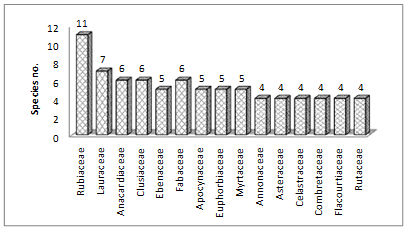
Figure 3.1: Family richness in Shirgunji MPCA
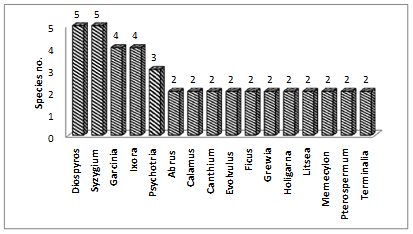
Figure 3.2: Generic richness in Shirgunji MPCA
Floristic diversity and Structure: Shirgunji MPCA forest though primarily composed of evergreen to semi-evergreen forest has been from earlier times been subjected to much exploitation as a minor forest (open to local privileges, especially closer to the village) resulting in higher degradation compared to Jankadkal MPCA. Shirgunji-31-T1 is a minor forest and in many places reduced to scrub. However due to control of fire forest is rich in evergreen species and highest number of species is seen in Shirgunji-mabgi-T2 (36 sp) followed by Shirgunji-T5 (33 sp). The number of species is also increased due to the inclusion of more deciduous species. Lowest number of species is seen in minor forest Shirgunji-31-T1 (22 sp) (Table 3.1)
Table 3.1: Shirgunji transects: Forest composition and basal area details (of trees).
Locality |
Taluk |
Forest type |
Total individuals |
Total species |
Average Height (m) |
Basal area (sq.m/ha) |
Shirgunji-31-T1 |
Kumta |
Semi-evergreen-minor forest |
124 |
22 |
12.7 |
27.7 |
Shirgunji-mabgi-T2 |
Kumta |
Semi-evergreen |
145 |
36 |
13.2 |
48.5 |
Shirgunji-mastikallu-T3 |
Kumta |
Semi-evergreen |
143 |
26 |
13.5 |
53.1 |
Shirgunji-mastikallu-T4 |
Kumta |
Semi-evergreen |
139 |
31 |
13.4 |
43.6 |
Shirgunji-T5 |
Kumta |
Evergreen |
118 |
33 |
11.6 |
34.3 |
Average height is also lower due to earlier logging and disturbance. Also many emergent climax species are also rare with more of sub-canopy trees such as Knema attenuata and Vitex altissima. Species area curve shows rising curve in spite of 5 transects implying some more sampling may be needed (Figure 3.3). Overall the diversity was not so high, the S.W index being under 2.85. Shirgunji-Mabgi-T2 (2.83) followed by Shirgunji-Mastikallu-T3 (2.80), had the highest Shannon diversity and others slightly less. Shirgunji-31-T1 had the least Shannon diversity (evenness index 0.8.). Semi-evergreen part of the forest is shown in Figure 3.4 and degraded portions illustration in Figure 3.5.
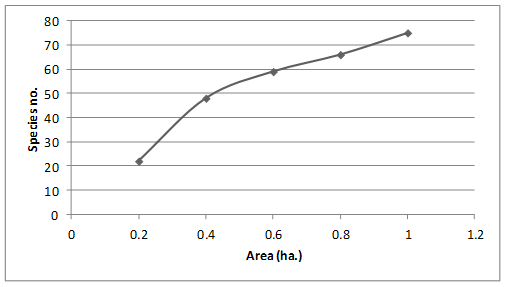
Fig. 3.3: Species area curve for Shirgunji MPCA

Fig. 3.4: Semi-evergreen patch adjacent to village in Shirgunji

Fig. 3.5. Degraded part of forest in Shirgunji MPCA
Important Value Index and Endemism: Most of the forests though having high number of evergreen species were having also fair mix of deciduous species, coming under higher IVI group (Tables 3.3 & 3.4). Knema attenuata was found as highest important tree in four transects followed by Holigarna ferrugeniana in one transect. Lophopetalum wightianum (Banate) a huge emergent tree having medicinal properties was also having second highest IVI in Shirgunji-Mabgi-T2 and Shirgunji-Mastikallu-T3 indicating existence of a richer forest in the past. However as earlier mentioned deciduous species were also high in most of these transects indicating past logging, fire, and other extraction pressures, at least till recent times, including ongoing. Vitex altissima (Bharanige), Terminalia paniculata ((Kindal), Lagerstroemia microcarpa (Nandi), Stereospermum colais (Patali) were seen in good numbers in most of transects. Although many of these are medicinally used plants their occurrence inside the evergreen to semi-evergreen along with Aporosa lindleyana and Olea dioica indicates logging, fire and other disturbances, at least in the past. As the forest gets converted from evergreen to secondary deciduous and further degradations (due to in Minor Forest category, where people were allowed to collect certain biomass) more of generalist and wide-spread medicinal plants tend to be more than the more sensitive ones and subject to high extraction pressures, such as Saraca asoca (Ashoka), Salacia sp (Ekanayaka), Coscinium fenestratum, Embelia ribes (Vayuvilanga) etc., which all require special microhabitats get scantier. As shortages happen for these important medicinal plants, exploitation of remaining plants in the wild is likely to intensify. Most of the forest, however, is semi-evergreen and one transect sample was in high evergreen (Figure 3.6). Western Ghat tree endemism was comparatively lower (34.3%) in the sample are Shirgunji-Mastikallu-T3, whereas the highest was in Shirgunji T5 (73.5%). This high endemism was mostly due to commoner endemics such as Knema attenuata, Hopea ponga, Holigarna sp etc., than rarer species of primary forests.
Table 3.2: Species richness, Shannon diversity, Simpson dominance, Simpson diversity, and Pielou’s evenness in Shirgunji MPCA.
Locality |
Species richness |
Shannon Diversity |
Simpson’s dominance |
Simpson’s diversity |
Pielou evenness |
Shirgunji-31-T1 |
4.357 |
2.481 |
0.139 |
0.861 |
0.802 |
Shirgunji-mabgi-T2 |
7.033 |
2.833 |
0.125 |
0.875 |
0.790 |
Shirgunji-mastikallu-T3 |
5.037 |
2.806 |
0.081 |
0.919 |
0.861 |
Shirgunji-mastikallu-T4 |
6.080 |
2.609 |
0.147 |
0.853 |
0.760 |
Shirgunji-T5 |
6.708 |
2.771 |
0.116 |
0.884 |
0.793 |
Table 3.3. Important Value Index of first ten tree species in T1, T2 & T3
Shirgunji-31-T1 |
Shirgunji-mabgi-T2 |
Shirgunji-mastikallu-T3 |
Sp |
IVI |
Sp |
IVI |
Sp |
IVI |
Knema attenuata |
54.26 |
Knema attenuata |
52.88 |
Holigarna ferrugeniana |
30.93 |
Vitex altissima |
42.77 |
Lophopetalum wightianum |
29.19 |
Lophopetalum wightianum |
29.20 |
Holigarna arnottiana |
28.78 |
Macaranga peltata |
17.49 |
Madhuca neerifolia |
28.31 |
Mangifera indica |
19.59 |
Myristica malabarica |
17.17 |
Vitex altissima |
23.85 |
Olea dioica |
18.94 |
Vitex altissima |
16.53 |
Aporosa lindleyana |
22.19 |
Pterospermum reticulatum |
18.08 |
Diospyros microphylla |
16.01 |
Olea dioica |
21.63 |
Holigarna ferrugeniana |
16.57 |
Holigarna ferrugeniana |
11.97 |
Holigarna arnottiana |
15.89 |
Ixora brachiata |
12.92 |
Beilschmedia fagifolia |
11.28 |
Terminalia paniculata |
13.04 |
Terminalia paniculata |
12.33 |
Holigarna arnottiana |
8.91 |
Syzygium caryophyllatum |
12.70 |
Beilschmedia fagifolia |
12.14 |
Neolitsea scrobiculata |
8.81 |
Hopea ponga |
11.63 |
Table 3.4. Important Value Index of first ten tree species in T4 & T5
Shirgunji-T4 |
Shirgunji-T5 |
Sp |
IVI |
Sp |
IVI |
Knema attenuata |
54.12 |
Knema attenuata |
45.76 |
Olea dioica |
34.67 |
Olea dioica |
27.49 |
Terminalia paniculata |
25.42 |
Flacourtia montana |
25.80 |
Vitex altissima |
20.64 |
Ficus nervosa |
16.16 |
Terminalia paniculata |
17.50 |
Garcinia indica |
13.45 |
Diospyros candolleana |
17.02 |
Hopea ponga |
13.24 |
Pterospermum diversifolium |
13.98 |
Lagerstroemia microcarpa |
12.93 |
Aporosa lindleyana |
9.38 |
Holigarna ferrugeniana |
12.89 |
Lannea coramandelica |
8.83 |
Stereospermum colais |
11.20 |
Cinnamomum malabatrum |
8.05 |
Elaeocarpus serratus |
9.93 |
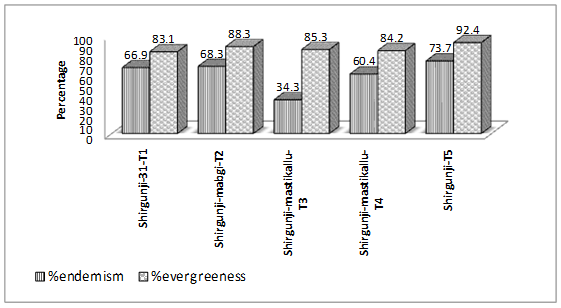
Fig. 3.6. Evegreenness and endemism% among trees in Shirgunji MPCA transects.
Medicinal plant diversity: A total of 122 medicinal plant species were recorded from the transect survey along with all out searches. However, the list cannot be exhaustive as we have missed seasonal herbs due to the limitation of the current study. Habit-wise 61 were medicinal trees, 21 shrubs, 20 climbers, and 20 herbs. Habitat wise evergreen to semi-evergreen forest patches accounted for 50 medicinal species; semi-evergreen–moist deciduous complex had 25 sp., while 16 species occurred in moist deciduous-scrub-savanna areas. Remaining occurred in other habitats such as grassy areas, streamside, seasonal marshes etc. (Annexure 2). Compared to Jankadkal, Shrgunji MPCA was found to experience higher disturbances due its proximity to villages. Whereas forest openings and other type of disturbance favour weeds and certain open area medicinal plants of commoner kinds many shade loving species were absent in heavily disturbed or open areas.
Transect wise medicinal plant composition: Altogether 92 medicinal species occurred in the transects-proper. Transect-wise details of total individuals of all flowering plants, total medicinal plant individuals, total species and total medicinal species are given in Table 3.5.
Table 3.5. Transect wise total medicinal plant individuals and species
Locality |
Total individuals |
Total medicinal plant individuals |
Total species |
Total medicinal plant species |
Shirgunji-31-T1 |
124 |
98 |
22 |
15 |
Shirgunji-mabgi-T2 |
145 |
108 |
36 |
23 |
Shirgunji-mastikallu-T3 |
143 |
104 |
26 |
22 |
Shirgunji-mastikallu-T4 |
139 |
112 |
31 |
21 |
Shirgunji-T5 |
118 |
95 |
33 |
24 |
Most transects had higher number of species with known for at least some medicinal properties, whether already recorded or used in folk medicine. The others cannot be written off as non-medicinal, as pharmaceutical research rapidly happening in various laboratories of the country and abroad is bringing out the hidden properties of many species day by day. Rarer medicinal species occur in shaded forest patches and commoner ones in open areas.
Girth classes: Girth class structure of Shirgunji tree community, especially of climax species and medicinal trees, shows a regular inverted “J” curve with highest number of stems found in lower girth class (30-59 cm range) representing set of growing stock (Figure 3.7). The paucity of trees in higher girth classes is glaring with least numbers occurring in >200 cm class, a situation that reflects past disturbances. Scarcity of larger, mature medicinal trees, will affect the future normal regeneration of such species due to unavailability of seeds. Hence for effective conservation of medicinal plants, trees and shrubs of all age classes are important and have to be maintained in tact as a community. Details of the regeneration of individual medicinal trees in seedling and sapling stages and in their higher girth classes are given in Table 3.6. This Table gives a complete picture of each medicinal tree and its regeneration status in terms of seedling and sapling and tree stages. Regeneration of medicinal shrubs and climbers is given in Figure 3.7.
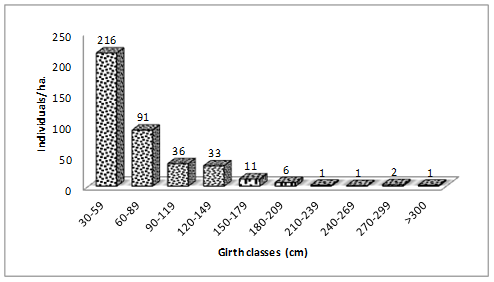
Fig. 3.7. Distribution of important medicinal and climax tree sp. tree individuals/ha., in Shirgunji MPCA (all transects pooled)
Table 3.6. Important medicinal and climax trees and no-trees (in seedling and sapling class) regeneration/ha.
Species |
|
|
Girth classes (in cm) |
Tot.
trees/ha. |
Seed-lings
/ha. |
Sap-
lings/ha. |
30-59 |
60-89 |
90-119 |
120-149 |
150-179 |
180-209 |
210-239 |
240-269 |
270-299 |
>300 |
Actinodaphne hookeri |
500 |
57 |
1 |
1 |
0 |
0 |
0 |
0 |
0 |
0 |
0 |
0 |
2 |
Ailanthus excelsa |
0 |
0 |
0 |
1 |
0 |
0 |
0 |
0 |
0 |
0 |
0 |
0 |
1 |
Alangium salvifolium |
0 |
6 |
0 |
0 |
0 |
0 |
0 |
0 |
0 |
0 |
0 |
0 |
0 |
Aporosa lindleyana |
286 |
149 |
7 |
6 |
1 |
1 |
0 |
0 |
0 |
0 |
0 |
0 |
15 |
Artocarpus hirsutus |
0 |
0 |
0 |
1 |
0 |
1 |
0 |
0 |
0 |
0 |
0 |
0 |
2 |
Calophyllum apetalum |
286 |
40 |
0 |
0 |
0 |
0 |
0 |
0 |
1 |
0 |
0 |
0 |
1 |
Carallia brachiate |
71 |
0 |
0 |
1 |
1 |
0 |
0 |
0 |
0 |
0 |
0 |
0 |
2 |
Careya arborea |
0 |
0 |
0 |
0 |
0 |
0 |
1 |
0 |
0 |
0 |
0 |
0 |
1 |
Cinnamomum malabatrum |
429 |
23 |
1 |
1 |
1 |
0 |
0 |
0 |
0 |
0 |
0 |
0 |
3 |
Dillenia pentagyna |
71 |
0 |
1 |
0 |
1 |
1 |
0 |
0 |
0 |
0 |
0 |
0 |
3 |
Diospyros candolleana |
357 |
303 |
11 |
3 |
0 |
0 |
0 |
0 |
0 |
0 |
0 |
0 |
14 |
Dysoxylum binectariferum |
71 |
6 |
1 |
1 |
0 |
1 |
0 |
0 |
0 |
0 |
0 |
0 |
3 |
Elaeocarpus serratus |
929 |
109 |
3 |
0 |
3 |
1 |
0 |
0 |
0 |
0 |
0 |
0 |
7 |
Ervatamia heyneana |
143 |
17 |
1 |
0 |
0 |
0 |
0 |
0 |
0 |
0 |
0 |
0 |
1 |
Flacourtia Montana |
1071 |
114 |
9 |
1 |
0 |
1 |
0 |
0 |
0 |
0 |
0 |
0 |
11 |
Garcinia cambogia |
714 |
34 |
0 |
0 |
0 |
1 |
0 |
0 |
0 |
0 |
0 |
0 |
1 |
Garcinia indica |
286 |
11 |
2 |
4 |
0 |
0 |
0 |
0 |
0 |
0 |
0 |
0 |
6 |
Garcinia Morella |
0 |
17 |
0 |
0 |
0 |
0 |
0 |
0 |
0 |
0 |
0 |
0 |
0 |
Grewia tiliifolia |
0 |
0 |
0 |
0 |
1 |
0 |
0 |
0 |
0 |
0 |
0 |
0 |
1 |
Holigarna arnottiana |
1429 |
46 |
4 |
8 |
4 |
3 |
0 |
0 |
0 |
0 |
0 |
0 |
19 |
Holigarna grahamii |
214 |
0 |
0 |
0 |
0 |
0 |
0 |
0 |
0 |
0 |
0 |
0 |
0 |
Homalium zeylanicum |
0 |
0 |
0 |
1 |
0 |
0 |
0 |
0 |
0 |
0 |
0 |
0 |
1 |
Hydnocarpus pentandra |
0 |
17 |
0 |
0 |
0 |
0 |
0 |
0 |
0 |
0 |
0 |
0 |
0 |
Ixora brachiata |
929 |
257 |
11 |
1 |
0 |
0 |
0 |
0 |
0 |
0 |
0 |
0 |
12 |
Knema attenuata |
6143 |
817 |
89 |
24 |
6 |
0 |
0 |
0 |
0 |
0 |
0 |
0 |
119 |
Lagerstroemia microcarpa |
0 |
0 |
1 |
0 |
0 |
1 |
0 |
1 |
0 |
0 |
0 |
0 |
3 |
Litsea laevigata |
0 |
11 |
1 |
1 |
0 |
0 |
0 |
0 |
0 |
0 |
0 |
0 |
2 |
Lophopetalum wightianum |
0 |
11 |
0 |
0 |
1 |
1 |
0 |
0 |
0 |
0 |
1 |
1 |
4 |
Macaranga peltata |
0 |
11 |
6 |
4 |
0 |
0 |
0 |
0 |
0 |
0 |
0 |
0 |
10 |
Madhuca neriifolia |
286 |
6 |
10 |
7 |
0 |
1 |
0 |
0 |
0 |
0 |
0 |
0 |
18 |
Mallotus philippensis |
0 |
97 |
2 |
0 |
0 |
0 |
0 |
0 |
0 |
0 |
0 |
0 |
2 |
Mangifera indica |
0 |
17 |
3 |
1 |
1 |
3 |
0 |
0 |
0 |
0 |
0 |
0 |
8 |
Mimusops elengi |
0 |
0 |
1 |
1 |
0 |
0 |
0 |
0 |
0 |
0 |
0 |
0 |
2 |
Myristica malabarica |
214 |
91 |
4 |
3 |
2 |
1 |
0 |
0 |
0 |
0 |
0 |
0 |
10 |
Neolitsea scrobiculata |
429 |
183 |
6 |
0 |
0 |
0 |
0 |
0 |
0 |
0 |
0 |
0 |
6 |
Nothopegia castaneaefolia |
2500 |
74 |
6 |
0 |
0 |
0 |
0 |
0 |
0 |
0 |
0 |
0 |
6 |
Lannea coromandelica |
0 |
0 |
0 |
0 |
1 |
1 |
1 |
0 |
0 |
0 |
0 |
0 |
3 |
Olea dioica |
1357 |
389 |
26 |
6 |
6 |
2 |
1 |
0 |
1 |
0 |
0 |
0 |
42 |
Persea macrantha |
71 |
0 |
0 |
1 |
1 |
0 |
1 |
0 |
0 |
0 |
0 |
0 |
3 |
Polyalthia fragrans |
714 |
97 |
1 |
0 |
0 |
0 |
0 |
0 |
0 |
0 |
0 |
0 |
1 |
Pterospermum diversifolium |
1000 |
11 |
1 |
1 |
0 |
1 |
0 |
0 |
0 |
0 |
0 |
0 |
3 |
Sageraea laurifolia |
286 |
74 |
1 |
0 |
0 |
0 |
0 |
0 |
0 |
0 |
0 |
0 |
1 |
Schleichera oleosa |
71 |
11 |
1 |
1 |
0 |
1 |
0 |
0 |
0 |
0 |
0 |
0 |
3 |
Stereospermum colais |
0 |
11 |
0 |
0 |
0 |
0 |
1 |
1 |
0 |
0 |
1 |
0 |
3 |
Strombosia ceylanica |
71 |
0 |
0 |
0 |
0 |
0 |
0 |
0 |
0 |
0 |
1 |
0 |
1 |
Syzygium caryophyllatum |
71 |
0 |
1 |
3 |
0 |
1 |
0 |
0 |
0 |
0 |
0 |
0 |
5 |
Syzygium cumini |
0 |
6 |
0 |
1 |
1 |
0 |
0 |
1 |
0 |
0 |
0 |
0 |
3 |
Syzygium gardneri |
0 |
6 |
0 |
0 |
1 |
1 |
0 |
0 |
0 |
0 |
0 |
0 |
2 |
Syzygium hemisphericum |
0 |
0 |
1 |
0 |
0 |
1 |
0 |
0 |
0 |
0 |
0 |
0 |
2 |
Terminalia bellirica |
0 |
0 |
0 |
0 |
0 |
0 |
0 |
0 |
0 |
0 |
0 |
1 |
1 |
Terminalia paniculata |
0 |
6 |
0 |
2 |
2 |
5 |
2 |
1 |
0 |
0 |
0 |
0 |
12 |
Toona hexandra |
0 |
0 |
0 |
1 |
0 |
0 |
0 |
0 |
0 |
0 |
0 |
0 |
1 |
Vitex altissima |
0 |
11 |
4 |
4 |
4 |
4 |
5 |
2 |
0 |
1 |
0 |
0 |
24 |
Commoner evergreens such as Knema attenuata, Nothopegia sp, etc., were more and sensitive climax species were rare. The ground layer was dominated hardy evergreens like Ixora brachiata, Olea dioica, Aporosa lindleyana, Holigarna arnottiana etc. indicating on-going disturbances. Through participatory management more care should be given to Uppage (Garcinia camboga syn G. gummigutta) and Kokum (Garcinia indica) fast emerging endemic medicinal plants, with rising global demands. Currently these trees are more represented in seedlings and saplings than in older stages. Mallotus phillippensis has a similar position and can be taken care more in semi-shaded areas. Developing more of Persea macrantha, Cinnamomum malabathrum, Myristica malabarica, Terminalia bellirica etc., all of which are medicinally very important and have potential habitats within the MPCA, requires greater attention. Nothapodytes nimmoniana and Strychnox nux-vomica may be grown experimentally, as it is natural zone for these species, despite their general absence currently. Important medicinal plants like such Salacia, Saraca, Embelia, Coscinium fenestratum etc., which could have been expected here were not noticed during the survey; probably due to over-exploitation, and therefore may be introduced in appropriate micro-habitats.

Fig. 3.7. Estimated climber and shrub population
|